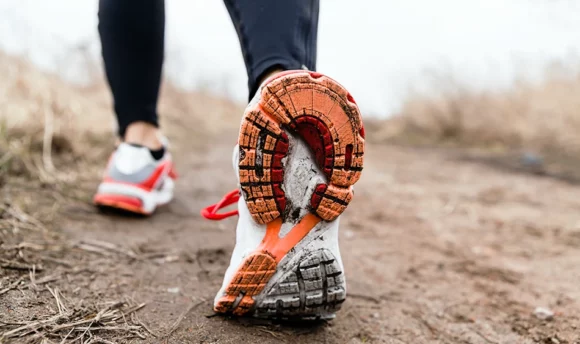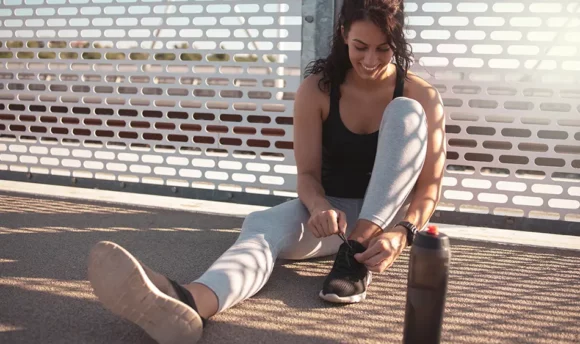How to Sprint Faster? Tips to Outrun the Competition
Are you ready to take your sprinting to the next level? Keep reading for 9 tips guaranteed to help you hit your next personal best.

Many athletes fall in love with sprinting because they love challenging their bodies and take pride in the power it produces. This love of sprinting leaves them always on the lookout for new tips and techniques that will help them hit their next personal best.
Does this sound like you? If so, then you’re in the right place!
In this article, we will provide deeper insight into the factors that impact sprinting speed and give you 9 must-have tips for how to sprint faster.
What Makes an Impact on Sprinting?
There are several factors that have an impact on sprinting performance, including:
Running form: Proper running form involves posture, sprint technique, and the actual movement that a runner performs while running. Practicing proper running form is a key factor in reducing the likelihood of injuries and improving the running economy.
The best way to improve running form is through feedback from a coach or experienced runner.
Fatigue: In the previous section, we mentioned something called running economy. Running economy refers to the management of energy while you run. A good running economy will help you utilize your oxygen and energy most efficiently, helping you run longer without getting fatigued.
The best way to improve the running economy is through practice. If you want to sprint faster, it’s best to practice sprinting drills that can improve cardiovascular health and muscular endurance.
Stride length: When it comes to stride length, there is no one-size-fits-all. A longer stride length results in a runner having to take fewer steps to cover a longer distance, but it also requires more strength and power. Shorter strides help to maintain more stability and control, especially at faster speeds.
A combination of stretching and strength training is the best way for a runner to improve stride length.
Breathing: Oxygen is a staple in energy production for the muscles. When the muscles lack oxygen, they create lactic acid, which slows down muscle function, and subsequent sprinting speed.
Breathing correctly, which means taking slow and rhythmic breaths, is one of the simplest ways to improve running performance. You can also try strengthening the upper back muscles to enhance running posture and to practice breathing exercises in between sprint training.
Muscle mass: Running may seem like a lower-body exercise, but the truth is that high-intensity sprint training involves all the major muscle groups. Strengthening the leg muscles helps create running force, the core muscles are responsible for stability, and strong arms help create more momentum when you run.
Spring training can help strengthen the muscles required for running. But it’s also recommended to cross-train with weights to maximize your muscle-building potential.
Hydration: How hydrated you are can affect your sprinting performance for a few reasons, the most important of which concern temperature regulation and electrolyte balance. Sweating is the easiest way for your body to expel heat when you’re running, but your body requires adequate levels of fluids and electrolytes to do so.
It’s best to hydrate up to an hour before you start running and to take a hydration supplement to ensure you have all the necessary electrolytes.
Sprinting Technique: 6 Tips to Improve Speed
If you’re looking for a step-by-step guide on how to sprint faster, you’re in the right place. In this next section, we’ll overview some of the most important changes you can make to your sprint technique to help you hit your top speed.
#1 Keep the right sprinting form
Adjusting your sprinting form is one of the most effective ways to hit faster speeds while running, allowing you to shave seconds off your 100m or 200m time. Some postural cues to keep in mind while running are the following:
- Keep your head tall and your shoulders down, lengthening the neck.
- Continue looking forward in the direction that you want to run. Don’t put your head down.
- Maintain a 90-degree bend through your elbows. Drive them alongside the body without allowing them to cross too far into the middle of your body.
- Drive your knees up with power after every stride.
- A slight forward lean is okay, but don’t allow too much bend through the torso.
#2 Practice proper breathing
In the previous section, we discussed the benefits that taking deep full breaths can have on your sprinting speed. The most important of which is providing the muscles of the entire body with the oxygen they need to function optimally.
Breathing deeply might sound simple enough in theory, but it can prove more difficult in practice. Here are some ways to enhance your breathing while running:
- Breathe through your nose and mouth simultaneously to encourage better airflow while preventing hyperventilating.
- Breathe all the way into your belly instead of only into your chest.
- Warm up your respiratory system before your run by practicing deep belly breathing.
#3 Warm up and stretch
Never underestimate the difference that warming up your muscles can have in helping you sprint faster.
A proper warm-up helps enhance blood flow, increasing the flow of oxygen and nutrients to your muscles. It also improves mobility through the muscles and joints, which can play an important role in maximizing running stride to hit high speeds.
Most importantly, a thorough warm-up can greatly reduce your risk of injury by preparing your muscles for activity and increasing muscle activation and overall coordination.
#4 Find your perfect running stride
For long-distance runners, using shorter strides and a higher stride frequency is a great way to reduce impact stress and improve running economy over long distances. But shorter strides might not be your best option if you’re looking for ways to sprint faster.
The perfect running stride to help you sprint faster is one that maximizes length without you having to sacrifice stability and control. If increasing your running stride is one of your goals, increasing the amount of stability and control you have while running is a must.
One of the best ways to do that is through a combination of high-intensity sprint training and strength training, specifically the muscles responsible for stability: the glute muscles, TFL muscles, and core muscles.
#5 Run on the balls of your feet
If you want to increase your burst speed to sprint faster, it’s important to focus on running on the balls of your feet as opposed to the heels. Running on the balls of the feet allows for a more powerful driving force and you to be lighter on your feet.
A heel-dominant foot strike causes a sinking sensation through the lower body, which impacts speed and puts more stress on the lower leg. Strengthening the calves through strength training exercises like straight-leg deadlifts is a great way to prevent a full foot strike while running.
#6 Don’t forget to use your upper body
We mentioned earlier that running, especially sprinting, involves the whole body. Although the legs do most of the work, the upper body plays an important role in supporting proper running posture and creating momentum while you run.
Strong latissimus dorsi and shoulder muscles contract to keep the chest open – even during a slight forward lean – to enhance breathing. The lats, in combination with your deltoids, are responsible for creating a strong driving force through the arm, helping to build momentum so sprinters can hit their top speed.
Because running is a more lower-body dominant exercise, it’s important to include upper-body exercises in your training program.
3 Extra Tips
Not all the work it takes to sprint faster happens on the track! In addition to improving your sprinting technique, be sure to add the following three tips to your training program. Doing so will help you see the best results, so you’ll be sprinting faster in no time.
#1 Get proper rest
In between workouts is when your muscles have the chance to repair, growing bigger and stronger than they were previously. What you do on your rest days and how often you take them are as important as working out. Rest days should never be viewed as wasted energy.
In addition to getting plenty of sleep, here are some recovery exercises you might want to do on rest days:
- Go for a walk or light jog.
- Enjoy a deep tissue massage.
- Go for an easy bike ride with friends.
- Foam roll or do deep stretches.
- Take a bath with Epsom salt.
#2 Practice clean eating
In order to sprint faster, providing your body with foods that are full of all the essential nutrients you need to support recovery and improve muscle growth is key. You want to eat a balanced diet of protein, carbohydrates, and healthy fats.
Remembering to eat within 30 minutes of finishing your workout is also important for anyone looking to maximize muscle growth. Packing a protein bar or protein shake in your gym bag is an easy way to ensure you always have a healthy post-workout snack available.
Some other post-workout meal options include yogurt and fruit, a sandwich on whole-grain bread, or a banana and peanut butter.
#3 Don’t forget HIIT and power exercises
Although sprinting is a full-body workout that can challenge all of your major muscle groups, cross-training with strength-building exercises is the best way to maximize running performance. It is also essential for preventing muscle imbalances, which can wreak havoc on the joints.
Certain muscles that are important for sprinting, like the calf and core muscles, aren’t easily strengthened through running alone. For that reason, it’s important to incorporate independent lower-leg and core exercises.
High-intensity resistance training is a great workout option for improving aerobic endurance while simultaneously increasing muscle strength throughout the entire body.
FAQs
A person’s average sprinting stride varies depending on factors such as leg length, height, and overall running style. Sprinters, on average, have a 20cm longer sprinting stride than distance runners.
Yes, for most individuals sprinting will be safe, regardless of blood pressure. However, it’s best to consult with a healthcare professional before starting any new physical activity, especially if you have a history of cardiovascular disease.
There is no singular “good” sprinting speed since how fast a person can sprint will depend on their gender, age, and physical condition. Recreational athletes should aim to finish a 100m race in under 17 seconds for women and 15 seconds for men.
A Word From Our Coach
Running of any kind provides a variety of mental and physical benefits. Regular runners can expect improved cardiovascular health, a boosted metabolism, improved mental clarity, and enhanced confidence levels.
Many people enjoy sprinting over long-distance running because it makes them feel more powerful and helps them build strength more quickly. But sprinters also have an increased likelihood of injury because this sped-up version of running can be harder on the body.
For that reason, it’s important that sprinters take extra precautions to reduce their chances of injuries. Some examples include spending extra time warming up, wearing appropriate footwear, and increasing distance and speed gradually with the help of a coach.
Listening to your body and honoring when you feel you need an extra rest day or don’t feel like you can give 100% is essential for keeping your body safe while you sprint.
Conclusion
Throughout this article, we’ve outlined some of the best tips for how to sprint faster. There are several different factors that impact sprinting speed, the most important of which are running form and proper breathing.
Anyone hoping to increase their running speed can benefit from improving their form and using a combination of running and strength training exercises to increase muscle strength.
In between workouts, it’s important to eat a healthy diet, including a variety of nutrient-rich foods, and pencil in the appropriate amount of rest days. Doing so will help you stay injury-free, so you can continue improving your running performance and enjoying the benefits of sprinting.

















































 Select your language:
Select your language: 








